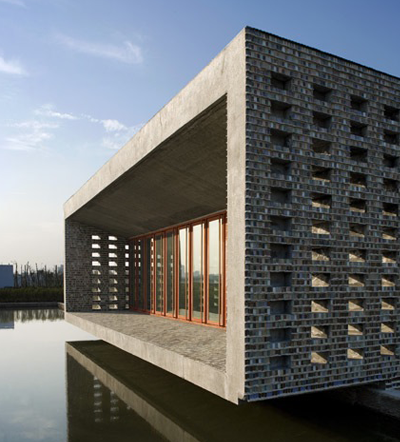
Ceramic House, 2003-2006, Jinhua, China. Photo by Lv Hengzhong.

When Hangzhou-based architect Wang Shu won the 2012 Pritzker Prize earlier this month, it marked a turning of the tide. Although the Pritzker, the discipline’s highest honor, has been awarded before to South American, Australian and Japanese architects, this is the first time it’s gone to a Chinese architect, and it seems just right. For too long people have understood high architecture as something that American and European designers practice and export to other parts of the world. Right now there’s a massive construction boom in China but it’s still projects designed by foreign offices, like OMA’s CCTV Tower and Herzog & de Meuron’s 2008 Olympic Stadium, both in Beijing, that grab the international spotlight. Although Shu has won major commissions throughout China and taught and lectured in the United States, he remains relatively unknown.
Shu’s buildings, designed with partner Lu Wenyu at Amateur Architecture Studio, have a distinctively earthy character. They’re massive volumes rendered with sensuous, tactile masonry surfaces. When he was young the architect worked for almost ten years on construction crews to master common building methods, and now he works closely with craftsmen to develop designs. He builds with everyday materials like poured concrete, fieldstone, and terra cotta tiles, which possess a reassuring heaviness. One of his signature strategies is to incorporate bricks and other materials salvaged from local demolition sites.
Slideshow
(more…)
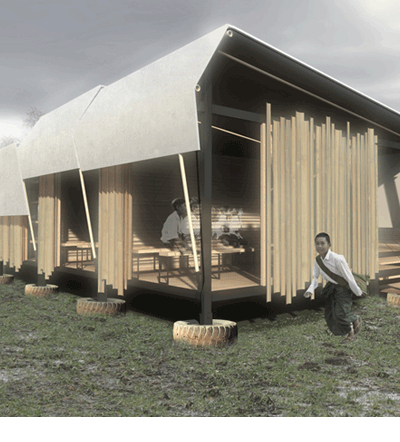
Winning design for Mae-Sot School. By Amadeo Bennetta / Daniel LaRossa, Berkeley, CA.

London-based architect David Cole was vacationing in Mae-Sot, Thailand, a town along the Burmese border, when he first learned about the plight of refugees there. Over the past twenty-five years some 30,000 Burmese have come to Mae-Sot to escape their country’s political violence. They live in camps with interim housing but without community buildings and schools. Cole warmed to the refugees he met, and saw the work that the
Burmese Migrant Workers Education Committee, the
Colabora Birmaina, and other organizations were doing on the ground.
After returning home, in order to build a school in Mae-Sot, Cole and industrial designer Louise McKillop founded
Building Trust International (BTI). The charity’s mission is to facilitate international building projects by assembling a specialized team of architects, engineers, sponsors, and other organizations. To solicit ideas for the Mae-Sot school, BTI organized an open design competition. The project brief called for a mobile structure that could serve as a school and community center. While the notion is simple the design problem isn’t. Since the refugees don’t have protected land rights, the structure has to be simple to assemble, transport and reassemble. And the structure needs to address the tropical climate, leverage local construction materials and techniques, and shape a deeply sheltering, inspiring space for the refugees. The competition attracted the interest of over 800 teams and some of the best entries were displayed at a pop-up gallery in London, generating even more interest.
Slideshow
(more…)
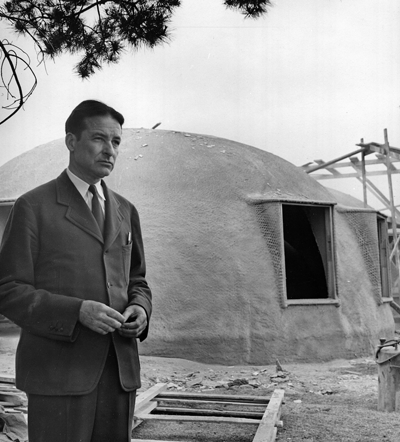
All photos from No Nails, No Lumber by Jeffrey Head (Princeton Architectural Press). Wallace Neff at an Airform construction site.

Architect Wallace Neff made a name for himself in the 1920’s and 1930’s building lavish Spanish-style mansions for Hollywood clients like Douglas Fairbanks, Groucho Marx, and Judy Garland. But his pipe dream was to fill the world with bubble houses: small, inexpensive, domed concrete structures that could be built in just a few days. A new book, No Nails, No Lumber: The Bubble Houses of Wallace Neff, tells the story of his efforts. From 1942 to 1952 Neff helped design and build thousands of bubble houses throughout the world, some of which remain in use even today. In addition to a number of individual bubbles houses in California, a community of twelve was constructed in Falls Church, Virginia, and another community of 1,200 was constructed in Dakar, Senegal. There were bubble house resorts developed in Hobe Sound, Florida and St. Thomas, Virgin Islands. And there were bubble houses built to use as grain storage bins in Litchfield Park, Arizona, as wine vats in Portugal, and as gas stations in Rio de Janeiro, Brazil.
The chief innovation of the bubble house was its patented Airform construction method. After a concrete foundation was poured in the ground, a heavy rubber bubble was inflated on top. Then the bubble was coated in layers of gunite (spray-on concrete), steel mesh, insulation,
Slideshow
(more…)
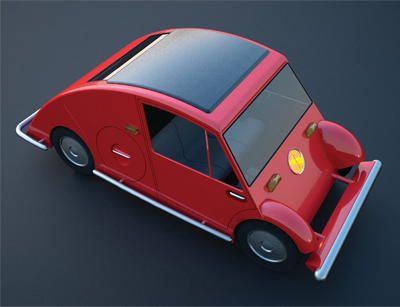
RENDERING RED Voiture Minimum, 1936, by Le Corbusier and Pierre Jeanneret. Virtual reconstruction by Antonio Amado Lorenzo.


Like movie stars who really want to direct, there were modern architects who really wanted to design cars. For early twentieth-century designers the automobile was much more than a vehicle; it was a powerful symbol of mobility, technology and progress. Walter Gropius and Adolf Loos both designed automobiles, and Le Corbusier’s design for a car called Voiture Minimum is documented in a new book of the same name. The narrative is less about the technicalities of automotive design, though, than about the great architect’s ambitions to build a car that embodied the ideas about space and form expressed so powerfully in his buildings. Le Corbusier designed Voiture Minimum with his cousin, architect Pierre Jeanneret, in 1936 as an entry to a competition sponsored by the French car manufacturer’s consortium SIA (Societe des Ingenieurs de l’Automobile). The competition guidelines didn’t govern style, but only specified the vehicle’s exterior dimensions, motor power, and retail price. Le Corbusier and Jeanneret put a great deal of effort into their design and, after it was submitted to SIA, approached different manufacturers and engineers to help put the model into production. While Le Corbusier built hundreds of structures throughout the world during his lifetime, he wasn’t able to build this car. All that remain of the project are pencil sketches and technical drawings, which historians have used to construct physical and computer models.
Slideshow
(more…)
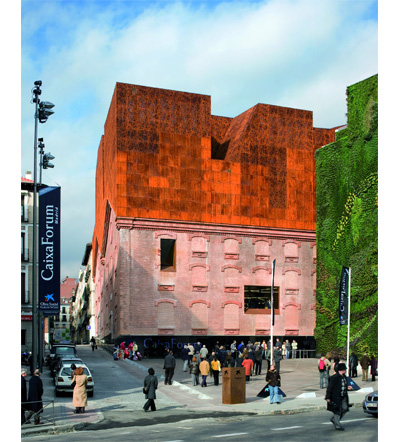
CaixaForum, Madrid, Spain, 2008. By Herzog and de Meuron.

There’s a kind of architecture that’s all about being a good neighbor, slipping into its surroundings without making a fuss. And there’s a kind of architecture that’s all about going right ahead and doing whatever it wants to do, without regard to what’s already there. The smart, contemporary addition and renovation projects highlighted in the book
Old Buildings, New Designs chart a course between these two extremes. While they honor the character and proportions of the older structures they’re enhancing, they’re built with unapologetically contemporary materials and forms. Instead of a nostalgia for historic styles or a fervor for futuristic ones, they find drama in the rich, raw contrast between old and new constructions.
Preserving and renovating old buildings has become an increasingly popular strategy. Building owners have limited funds for construction, designers are more interested in historic preservation and material conservation, and, globally, populations are migrating from rural communities to cities. So designing functional, attention-grabbing additions has become an important field of architecture and urban planning. In the projects featured in the book, sometimes a new interior is carved into the shell of existing structure, and sometimes an entirely new structure is built alongside the existing one.
Slideshow
(more…)

All photographs by Mathias Braschler and Monika Fischer, courtesy of Hatje Cantz. Juliana Pacco Pacco, llama herdswoman. Paru Paru, Peru.

Climate change is notoriously difficult to illustrate. Shifts in sea level, soil acidity, and air composition occur slowly and over such long periods of time that they can’t grab headlines the way more dramatic, photographable events like wars, debates and protests do. Photographers Mathias Braschler and Monika Fischer have brought the issue to the forefront by documenting men and women in rural communities around the world whose way of life has been unravelled by climate change. Their book of portraits and interviews, The Human Face of Climate Change, is a powerful political document, giving an inescapable, emotional face to the issue.
The color photographs of these men and women are vivid, but what’s more powerful is their personal testimony. Each one has made a brief, page-long statement, that’s been translated into English in simple, declarative sentences that emphasize the gravity of what they’ve seen. All have observed climate change in their own communities and in their own lifetimes, over a span of just ten or twenty years. And all of them – in the Americas, Africa, and Asia — have the same stories to tell: their bodies of water are shrinking, their shorelines are eroding, their glaciers are melting, and their soils are becoming less fertile. Some of the evidence is tragic.
Slideshow
(more…)
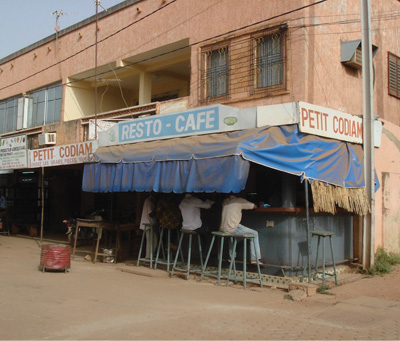
All photographs copyright David Adjaye, African Metropolitan Architecture, Rizzoli New York, 2011. Ouagadougou, Burkina Faso.


For many of us who’ve never been there, Africa is a myth more than a place, an imaginary landscape of unspoiled deserts, grasslands and forests. So
David Adjaye’s new book of photographs of the continent’s cities,
African Metropolitan Architecture, is revelatory. Adjaye is a celebrated London-based, Tanzania-born architect who has traveled through Africa since he was a child. This seven-volume set collects thousands of photos he took when visiting fifty-two different cities over the past decade. The book is organized geographically, with separate volumes featuring cities in the Maghreb (the northwest shore), the Sahara desert, the Sahel (the zone just south of the desert), the forest, the savanna, and the mountains.
Adjaye’s photographs aren’t rigidly composed, as one would expect from an architect, and have a snapshot-like immediacy. They look as if they were taken by a traveler moving comfortably and inconspicuously through these places, with a personal rather than academic interest. But Adjaye is highly deliberate about what he chooses to photograph, focusing on buildings, streets, parks and plazas that capture the spirit of each city’s life.
Click for Slideshow
(more…)
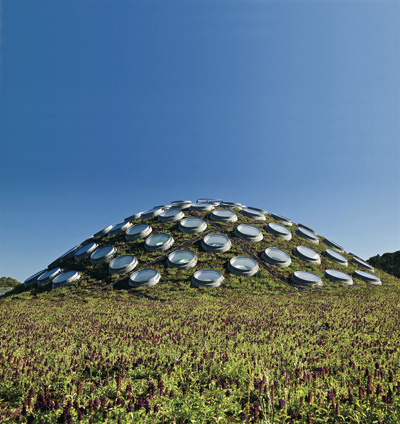
Green roof at California Academy of Sciences, San Francisco, California. By SWA Group.

When the first stretch of the Highline opened in New York City in 2009, it changed the game for contemporary American landscape design. The city park, built on an unused, raised railroad track in Manhattan, is a bold step forward. Its pathways are finished with industrial materials like concrete and steel, its plantings are squeezed into narrow swatches, and its views are stuttered and surprising. It’s a huge contrast to the city’s other great park, Central Park, which was designed by the legendary nineteenth-century landscape designer Frederick Law Olmsted. The older park lures visitors with pretty, painterly, panoramas that seem to unfold naturally as they walk through. The Highline breaks free from these longstanding conventions, and falls right in sync with the current directions in landscape design, which are captured in the new book “Futurescapes: Designers for Tomorrow’s Landscape Spaces.”
What’s striking about these new landscapes is how informal so many of them seem. Are these gardens, or patches of undisturbed wildlife? The truth is that even the most carefree-feeling new gardens are painstakingly orchestrated, created by landscape designers with a deep knowledge of plant types, climate and geology.
Click for Slideshow
(more…)
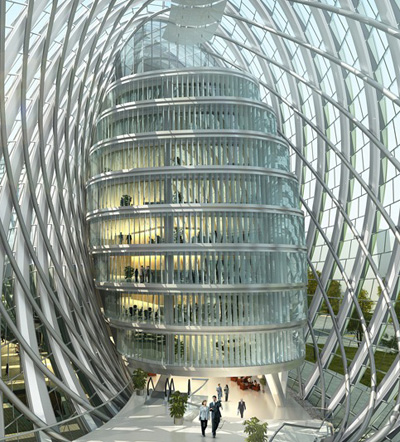
Phoenix International Media Center, Beijing, China, 2007-2009. By BIAD_UPo.

Ten years ago there was a joke that half of the world’s construction cranes were in Dubai. Today the joke might be that half of the world’s construction cranes are in mainland China, and that factories in China are producing more cranes every day. There’s been cataclysmic industrialization there and, along with it, an awesome amount of new construction. Old neighborhoods are being razed and, with incredible speed, gleaming new cities are rising. An exhibit at Rome’s modern art museum MAXXI, “Verso Est: Chinese Architectural Landscape,” takes a closer look at the architecture that’s emerging.
Because of relatively unregulated city planning and construction, buildings get built in China more quickly than they could ever get built in North America or Europe. So while New Yorkers wait and watch Tower One rise at the World Trade Center site, Beijing’s Central China Television (CCTV) headquarters by Rem Koolhaas, which was designed at the same time, has already been open for over a year. The breakneck pace of construction is impressive and also risky. Before it’s opening in 2010 the entire exterior shell of the CCTV tower went up in flame when some stray fireworks hit it. It’s an accident that probably wouldn’t have happened at an American building site, where federal safety standards ensure that building materials are fire resistant.
(more…)

Mark 1 Tomato Worm Suit, by B. F. Goodrich.

Forty-two years after Neil Armstrong landed on the moon, the bulky, crinkly white spacesuit he wore remains an icon of the space age. While the suit was engineered by NASA to meet exacting technical standards, it was actually assembled by underwear seamstresses. This is just one intriguing aspect of spacesuit design that’s documented in the new book “Spacesuit: Fashioning Apollo,” by Nicholas de Monchaux.
When NASA first engineered the suits for the Apollo missions they wanted them to have a cold, hard, mechanical look. But the shell-like suit prototypes they produced, which made astronauts look like the Michelin Man, weren’t especially comfortable or flexible. So NASA used layers of lighter materials stitched together. The special twenty-one-layer assembly they devised had nylon inside for comfort, teflon outside for protection, and rubber-dipped fabrics in between to withstand pressure.
Click for Slideshow
(more…)





 Facebook
Facebook Permalink
Permalink Digg
Digg Reddit
Reddit LinkedIn
LinkedIn StumbleUpon
StumbleUpon Tumblr
Tumblr












